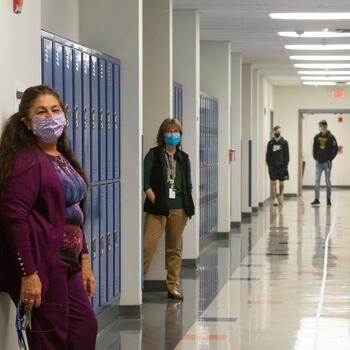December 12, 2021
A year ago, we wrote a blog about the anticipated impacts of the COVID-19 pandemic on the already significant shortages of teachers in specific subjects and regions across the U.S. In the time since, research has shown that the pandemic led to teachers reporting higher stress and being more interested in leaving the profession. A survey of U.S. teachers done by RAND found that nearly 1 in 4 teachers said that they were likely to leave their jobs by the end of the 2020–2021 school year, up from one in six teachers in earlier years. And Black teachers were particularly likely to plan to leave. The teachers surveyed cited pandemic-era teaching conditions, such as technical problems while teaching remotely, as linked to job-related stress, depressive symptoms, and burnout.
As before the pandemic, shortages persist, and districts and schools are working to understand their own staffing needs all while meeting the needs of their staff. As you consider your teachers’ and district’s needs, you should ask yourself- What is causing the shortages in my district? How can I strengthen my district’s workforce? And what would it take to improve working conditions here? We've collected resources below to get you started.
Understanding what causes shortages:
Using rapid pulse check surveys and collaboration to assess teaching conditions
Center on Great Teachers & Leaders (GTL Center)
The GTL Center facilitated a Community of Practice with 5 state education agencies to develop a framework for assessing teaching conditions and create a set of rapid pulse check surveys to monitor teacher perspectives on their rapidly evolving and adapting learning settings (e.g., remote, hybrid). Schools and districts can implement these pulse check surveys routinely throughout the school year to observe trends in teacher perceptions of working conditions over the course of a school year.
Lost to the System? Descriptive Exploration of Where Teacher Candidates Find Employment and How Much They Earn
National Center for Analysis of Longitudinal Data in Education Research (CALDER)
This resource from CALDER uses data on over 14,000 teacher candidates in Washington state and employment data from the state’s public schools and Unemployment Insurance system to investigate the career paths and earnings of teacher candidates.
Teachers who aren’t teaching
Regional Educational Laboratory (REL) Midwest
This 30-minute public television program, produced by REL Midwest, presents research on the reasons many certified teachers are not teaching in public schools along with the incentives that would motivate them to return to the classroom. The program suggests ways that state policymakers and district leaders can develop recruitment and retention strategies to address teacher shortages through tailored efforts.
Planning to strengthen a district’s workforce:
District Metrics for Quality Remote Hybrid Learning Community of Practice
Region 1 & Region 9 Comprehensive Center
The Region 1 and Region 9 Comprehensive Centers (R1CC and R9CC) is collaborating with state education agencies in Illinois, Iowa, Maine, Massachusetts, New Hampshire, and Vermont on a community of practice that supports districts in assessing the quality of remote or hybrid teaching models.
Strengthening the Teacher Workforce through Selection Processes
National Comprehensive Center (CCNetwork)
This report from the National Comprehensive Center considers the disruptions to the teacher workforce caused by the COVID-19 pandemic, including budget cuts, hesitation to return in-person to the classroom, and relaxed hiring standards. The brief suggests literature-based strategies improve the teacher selection process and add relevant tools to more reliably identify the most promising teacher candidates.
Creating better working conditions:
Transforming the culture of education: Improving teacher working conditions
Regional Educational Laboratory (REL) Midwest
This short documentary from REL Midwest explores how districts and schools can create supportive working environments for teachers. The documentary explores teacher working conditions including school environmental factors that influence teacher job satisfaction and focuses on three elements of teacher working conditions: leading schools to success, empowering teachers through leadership, and creating meaningful professional development.
Creating inclusive workplaces for Black teachers
Regional Educational Laboratory (REL) Midwest
This Regional Educational Laboratory (REL) Midwest video explores why Black teachers leave the teaching profession and the best practices for retaining them. A second video recommends steps education leaders can take to determine what strategies will have the biggest influence on creating work environments that are culturally affirming and promote the retention of Black teachers. Additionally, REL Midwest developed an infographic summarizing research and strategies for diversifying the teacher pipeline.
So what's next?
As you head into winter break, and then the start of a new hiring season, we hope these resources will support you in improving teacher working conditions and strengthening your workforce. We’d love to hear from you about the successes and challenges related to hiring and work culture in your district. Please reach out with your stories!
